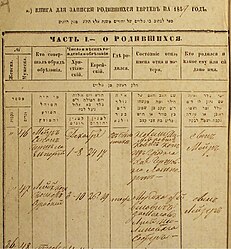
Whether your ancestors came from Poland, the Czech Republic, Hungary, Romania, Slovakia, Russia, Ukraine, or other countries, it’s likely that their extant records have found their way into the government’s archive system. While administrative divisions may differ by country, Eastern European governments have been taking a larger role in the record-keeping process since the beginning of the twentieth century. Many archival collections are now digitized, with more records coming online all the time.
While a substantial number of Eastern European genealogy records have been digitized and placed on various websites, there are still a significant number of archived records that are not yet online. Other more traditional sources such as church registers, cemetery records, printed books, maps, gazetteers, histories, and microfilmed records must also be explored. DNA testing and researching out to living relatives “across the pond” can assist with making connections to find more information.
Brief geo-political history of Eastern Europe
Understanding the geopolitical complexities, as well as the civil and ecclesiastical jurisdiction changes that came with them, is key to identifying and finding available records. The Holy Roman Empire was the major political entity in the heart of Europe between 1500 and 1806.[1] The Austrian Empire began in 1814 and the Austro-Hungarian Empire, or the Dual Monarchy, after 1867. The Empire lasted until the end of World War I in 1918. Some areas in Eastern Europe (such as Prussia) were a part of the German Empire. The German Empire was created in 1871 by the combination of the Kingdom of Prussia with other German kingdoms, principalities, duchies, and other independent states. Russia, Belarus, Ukraine, Moldova, and the Baltics were previously in the Russian Empire. Russia was an independent country for many centuries, then following the Bolshevik Revolution of 1917 and the subsequent Russian Civil War of 1918-1930 became the Russian Soviet Federative Socialist Republic (RSFSR), a republic of the Union of Soviet Socialist Republics (USSR). Russia is now known as the Russian Federation since the dissolution of the Soviet Union in December 1991.
Finding Online Records in Eastern Europe
Because borders place names and county, province, and state jurisdictions in Central and Eastern Europe have changed considerably over the centuries, this often makes it difficult to determine which archive has the records you need. Because of these changes, you may not be able to find the name of your ancestor's town on a modern map, so online or printed atlases, maps, and gazetteers (geographical dictionaries) should be consulted. Pinpointing places is key so you can determine the closest local, regional, or national archive where records are housed. On MyHeritage, along with searching through international records, you can also use the search engine interface in 42 different languages. You can also perform a Google search for the country and the word “archive.” Using the country-specific version of Google (google.sk, google.pl, etc.) may offer additional online resources. Once on the archive’s website, look for an English button to help translate the page or finding aid and read the directions. (Help, FAQ, About this site, etc.).
Key record sets

Record coverage will vary by locality and time period. Privacy laws may restrict online access. Check websites for the following record types:
- Church records
- Civil registration records
- Censuses
Also look for underused sources, such as:
- Seignorial records
- Military records
- Tax/Revision lists
- Books, periodicals, or newspapers
Records in Eastern Europe were kept in a mélange of different languages. Which languages those were used will depend on the time period, the religion and ethnicity of the person named in the records and the official administrative language (typically Latin, German, Hungarian, Polish, and Russian) of the nation under whose jurisdiction the locality fell. You don’t need to be fluent in these languages to research your ancestors. What you do need is an understanding of the history of vital records, knowledge of the rubrics common to the records, and techniques for deciphering hard-to-read handwriting. Learn key terms that you will find in records such as: fond (folder), opis (description), sprava (case/folder). Online dictionaries or word lists can help or use translation tools such as Google Translate or Yandex.
Facebook groups for Eastern European genealogy research
Search Facebook for groups related to the Eastern European Country/Ethnicity you are researching. Active groups exist for Czech, Hungarian, Jewish, Polish, Slovak, Ukrainian, as well as other countries. Check out the MyHeritage Facebook Page for resources and presentations related to Eastern European genealogy research. The Genealogical Translations group is a good place to get additional help for hard-to-read documents or language-related brick wall issues.
Explore more about How to Research Eastern European Archives Online
- Czechia, Church Books, 1552-1948 record collection at MyHeritage
- Germany, Prussia, Pomerania Church Records, 1544-1945 record collection at MyHeritage
- Jewish Holocaust Memorials and Jewish Residents of Germany 1939-1945 record collection at MyHeritage
- Poland, Lublin Roman Catholic Church Books, 1784-1964 record collection at MyHeritage
- Poland, Tarnow Roman Catholic Diocese Church Books, 1612-1900 record collection at MyHeritage
- Slovakia, Church and Synagogue Books, 1592-1910 record collection at MyHeritage
- Break Down Brick Walls in Eastern European Research – Tips, Tools and Tricks at Legacy Family Tree Webinars
- Survival Skills for Eastern European Genealogists at Legacy Family Tree Webinars
- Researching Eastern European Archives from Your Easy Chair at Legacy Family Tree Webinars
- Locating and Accessing Eastern European Church Records at Legacy Family Tree Webinars
- Locating and Accessing Eastern European Civil Records at Legacy Family Tree Webinars
- Where is That? Using Eastern European Atlases, Maps and Gazetteers at Legacy Family Tree Webinars
References
- ↑ Holy Roman Empire. World History